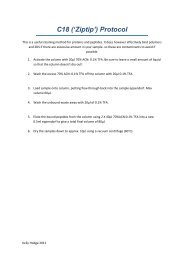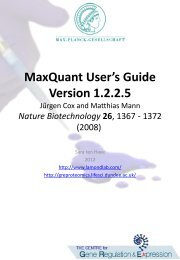SCX -TiO2 Phospho- peptide Separation Protocol - GRE Proteomics ...
SCX -TiO2 Phospho- peptide Separation Protocol - GRE Proteomics ...
SCX -TiO2 Phospho- peptide Separation Protocol - GRE Proteomics ...
You also want an ePaper? Increase the reach of your titles
YUMPU automatically turns print PDFs into web optimized ePapers that Google loves.
<strong>SCX</strong> -<strong>TiO2</strong> <strong>Phospho</strong>- <strong>peptide</strong><br />
<strong>Separation</strong> <strong>Protocol</strong><br />
Sara ten Have 2009<br />
Phosphatase inhibitors HIGHLY recommended. Do not dry phospho-petide eluent as these <strong>peptide</strong>s<br />
will stick to sample tube. Note pH of samples ~pH2 is optimal, as well as a long incubation time at<br />
room temperature for successful binding to <strong>TiO2</strong>.<br />
Protein Digestion<br />
• 100mM Iodoacetamide in 25mM NH4HCO3<br />
• 45mM DTT in 25mM NH4HCO3<br />
1µg/µl Trypsin Gold (50mM acetic acid reconstituted)<br />
•<br />
Firstly ensure your protein mixture is very near to pH 8, the optimal operating pH of Trypsin. Adjust<br />
as necessary.<br />
1. Take an aliquot and combine with running buffer (SDS PAGE running buffer) if required for<br />
digestion monitoring.<br />
2. Add 45mM DTT (to a final concentration of 10mM), vortex and incubate at 50 o C for 15mins.<br />
3. Allow to cool slightly, then add 100mM Iodoacetamide (to a final concentration of 20mM),<br />
incubate at room temperature, in the dark, for 15mins.<br />
4. Add Trypsin (1:100 (µg to µg) enzyme to substrate ratio, if Trypsin gold) and incubate over<br />
night at 37 o C.<br />
5. Take an aliquot and run with initial aliquot to test digestion efficacy if required.<br />
6. Clean sample over Empore universal resin or Ziptip equivalent (C18 material)<br />
Cleaning protocol with Thermo Scientific Hypersep C18 resin<br />
(60300-422, 25mg/1ml)<br />
1. Prime column with 2x 1ml MeOH.<br />
2. Wash column with 2x 1ml 0.1% TFA.<br />
3. Add 1ml of 0.1% TFA as well as your sample and another 1ml of 0.1%TFA (use to wash out<br />
remainder of sample form eppendorf). Elute slowly through the column.<br />
4. Wash with 2x 1ml 0.1% TFA.<br />
5. Elute sample with 2x 500µl 70% ACN/0.1% TFA.<br />
6. Dry down samples to a small volume (≤200µl). Retain a aliquot of this sample- for the whole<br />
protein picture (sample 1- all proteins)
<strong>SCX</strong> Poly-<strong>Phospho</strong>-<strong>peptide</strong> Enrichment, Thermo Scientific Hypersep <strong>SCX</strong><br />
(benzosulfonic acid, 25mg/1ml)<br />
As <strong>TiO2</strong> tends to bind phospho-<strong>peptide</strong>s very strongly, and tends to not elute poly- phosphorylated<br />
<strong>peptide</strong>s, it has proven more effective to perform an <strong>SCX</strong> Isolation first- to isolate poly-phosphos and<br />
then the remaining mono-phosphos can then be captured with the <strong>TiO2</strong>, and be successfully eluted.<br />
• <strong>SCX</strong> Buffer A (loading and washing buffer): 10mM KH2PO4, 25% ACN, pH 3.<br />
• <strong>SCX</strong> Buffer B (priming and elution buffer): 10mM KH2PO4, 25% CAN, 350mM KCl, pH3.<br />
Reconstitute sample in Buffer A (500µl-1ml), and test the pH- making sure it is pH2-3.<br />
1. Wash Column with 2x 1ml of MilliQ.<br />
2. Prime the Column with 2x 500µl <strong>SCX</strong> Buffer B.<br />
3. Wash the Column with 2x 1 ml <strong>SCX</strong> Buffer A.<br />
4. Load sample, push through column slowly, retaining the flow-through as this will be applied<br />
to the <strong>TiO2</strong>. This sample should be speed-vac’d down to a volume of approximately 100µland<br />
then used in step one of the <strong>TiO2</strong> separation protocol.<br />
5. Wash the sample with 2x 500µl <strong>SCX</strong> buffer A.<br />
6. Elute sample with 500µl of <strong>SCX</strong> Buffer B (sample 2- Poly-phospho <strong>peptide</strong>s).<br />
NB: This sample should be cleaned (C18) as it contains a large amount of salt, which will cause<br />
problems with the LC-MS analysis. Remember to NEVER dry a phospho sample completely- as the<br />
<strong>peptide</strong>s will stick to the tubes.<br />
<strong>TiO2</strong> <strong>Separation</strong>.<br />
This protocol is performed using 500µl eppendorfs instead of tips to allow for longer binding time<br />
and instead of elution from a tip, a spinning and supernatant approach is used.<br />
• Loading buffer: 80% ACN/2% TFA and 200mg DHB, pH 2.<br />
• Washing buffer: 80% ACN/ 2%TFA, pH 2.<br />
• Elution buffer: 400mM NH4OH, pH 11.<br />
1. Re-suspend reduced sample (from step 4 above) in 80% ACN, 2% TFA and 200mg/ml DHB.<br />
Check the pH is 2.<br />
2. To a micro spatula full of <strong>TiO2</strong> beads in a 500µl eppendorf add 100µl 80% ACN, 2% TFA and<br />
~200mg/ml DHB, and vortex for 10 seconds. Spin at 1000g. Remove supernatant and repeat.<br />
3. Add sample to beads, seal well and rotate at room temperature for 1 hour.<br />
4. Spin down at 1000g, remove the non-phosphorylated <strong>peptide</strong>s. Retain if necessary (<br />
although this sample contains large amounts of DHB- which is good for MALDI- not so good<br />
for Electrospray MS, and is quite difficult to remove).<br />
5. Wash 3 x 100µl with 80% ACN, 2% TFA and 200mg/ml DHB.<br />
6. Wash 3x 100µl with 80% ACN, 2% TFA (note the yellow color should dissipate).<br />
7. Elute phospho-<strong>peptide</strong>s with 2x 30µl 400mM NH4OH pH 11.
8. Add 5µl of 100% formic acid to adjust pH and load directly to MS plate or clean over C18<br />
and ESI-MS/MS (sample 3- mono phospho <strong>peptide</strong>s).





